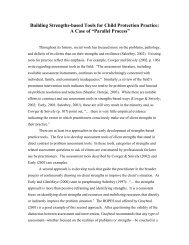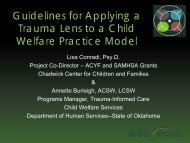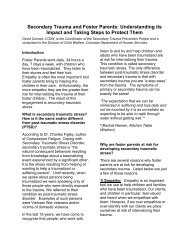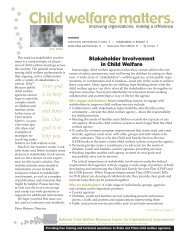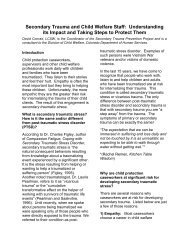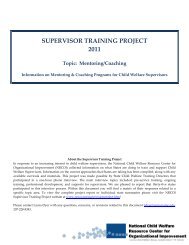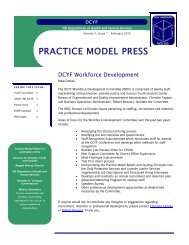Building a Model and Framework for Child Welfare Supervision
Building a Model and Framework for Child Welfare Supervision
Building a Model and Framework for Child Welfare Supervision
Create successful ePaper yourself
Turn your PDF publications into a flip-book with our unique Google optimized e-Paper software.
A Continuum of Initial <strong>and</strong> Ongoing Training <strong>for</strong> Supervisors Including Peer Support,<br />
Mentoring, <strong>and</strong> Clinical Consultation. A primary obstacle to effective child welfare supervision<br />
most consistently identified by key in<strong>for</strong>mants <strong>and</strong> by the<br />
literature (e.g., Center <strong>for</strong> Advanced Studies in <strong>Child</strong><br />
<strong>Welfare</strong> 2009; Faller 2003; NRCOI 2007; Robison 2006)<br />
is the pervasive lack of ongoing supervisory training.<br />
Although the <strong>Child</strong> <strong>and</strong> Family Services Reviews found<br />
that ongoing training is offered to frontline practitioners in most states (CFSR final reports are<br />
available at http://basis.caliber.com/cwig/ws/cwmd/docs/cb_web/SearchForm), generally training<br />
<strong>for</strong> supervisors is either non-existent or focuses on practice-relevant topics. For example, a<br />
supervisory training session might focus on domestic violence, without addressing how supervisors<br />
should specifically apply the content in their role with supervisees.<br />
Other obstacles to supervisory practice<br />
Insufficient training is the biggest obstacle to<br />
identified by key in<strong>for</strong>mants <strong>and</strong> the literature effective supervision. The state is currently in the<br />
include uneven provision of accessible <strong>and</strong><br />
process of creating supervisory training <strong>and</strong> tools<br />
in<strong>for</strong>med supervision <strong>for</strong> supervisors <strong>and</strong> the<br />
to help guide them in their support of workers <strong>and</strong><br />
lack of regularly available peer support,<br />
mentors, <strong>and</strong> clinical consultation. To address cases. – Administrator<br />
these obstacles, organizations must:<br />
• Make training an accepted part of everyone’s job. Day-to-day job dem<strong>and</strong>s shouldn’t put<br />
training on the “back burner.” "Ensure extra staffing to allow <strong>for</strong> training attendance" (Blase &<br />
Fixsen 2004).<br />
• Demonstrate the value placed on training <strong>for</strong> supervisors by expecting, encouraging, <strong>and</strong><br />
ensuring supervisory participation in training events.<br />
• After training events, rein<strong>for</strong>ce key learning points to ensure that<br />
classroom skills are used in day-to-day work.<br />
There is a lack of<br />
ongoing training<br />
• Provide a continuum of educational supports <strong>for</strong> supervisors, including that’s really targeted<br />
initial <strong>and</strong> early in-service; regularly scheduled supervision;<br />
to supervisor<br />
accessibility to mentors <strong>and</strong> clinical consultants; <strong>and</strong> accessibility to competencies. You<br />
structured, regularly scheduled peer learning <strong>and</strong> support groups, such<br />
can go to substance<br />
as facilitated learning labs <strong>and</strong> peer group case review <strong>and</strong> problemsolving.<br />
abuse training, but<br />
it’s not targeted to<br />
• Ensure that training design <strong>and</strong> content balance knowledge <strong>and</strong> skillsbuilding<br />
in the administrative, educational, <strong>and</strong> supportive aspects of<br />
supervisors. –<br />
supervision; <strong>and</strong> include instruction <strong>and</strong> practice in sharing <strong>and</strong><br />
Supervisor<br />
applying the learning with supervisors’ teams/units.<br />
• Offer training opportunities in varied <strong>for</strong>mats <strong>and</strong> locations (e.g. on-line, local classroom,<br />
teleconference, webcast, partial day <strong>for</strong>mat, interactive web-based, etc.) to accommodate<br />
supervisors’ dem<strong>and</strong>ing responsibilities <strong>and</strong> schedules<br />
Administrators <strong>and</strong> managers must communicate the importance of ongoing educational support <strong>for</strong><br />
supervision, <strong>and</strong> consistently expect <strong>and</strong> protect supervisors’ participation. For example, placing<br />
supervisors in double-bind situations by requiring their attendance at meetings scheduled in conflict<br />
with supervisory training or peer group meetings conveys to supervisors <strong>and</strong> all agency staff that<br />
ongoing supervisory training is not a priority.<br />
36<br />
When you first become a supervisor<br />
there is good training, but no ongoing<br />
training is provided. – Supervisor




